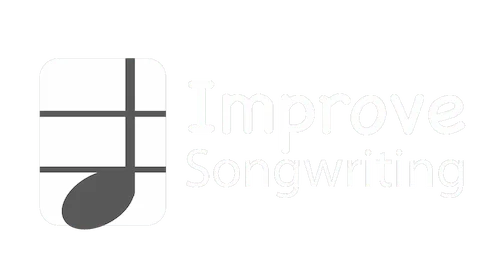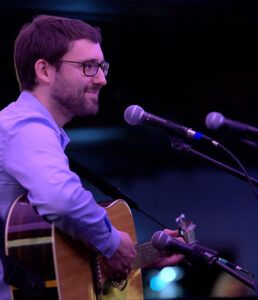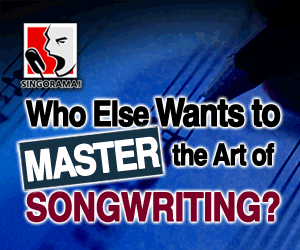If you’re looking for ways to improve lyric writing, we’ve got 9 tips that should help you out, broken down into the areas of lyric inspiration, technique, and structure.
There are so many different types of music out there today that it would be impossible to cover every type of genre. But no matter which area of music is your specialty, if you want to become a successful songwriter, you’ll need to master lyric writing.
These 9 lyric writing tips will help you get there! By the end of this article, you’ll be able to write better lyrics without even thinking about it.
Improve your songwriting by mastering piano.
$49
ONLY
9 Lyric Writing Tips for Better Lyrics
Section 1: Inspiration Tips
1) Document Every Idea
When you’re writing lyrics, sometimes your creative juices run dry. You know you need to say something different than what you’ve heard before, but you don’t know where you can find the inspiration.
If you’ve gotten to this point, you’re already behind! The truth is that many lyricists keep a log of all the ideas that come to them as they go about their lives. Inspiration strikes when you least expect it, and you’d be insane not to want to capture it when it does.
Personally, I have a Google Doc file for all the poetic phrases that come to my mind when I’m exiting the shower or waking up from a dream. But feel free to keep a physical notepad or small journal with you if that makes you more comfortable.
After a while, you’ll have a backlog of ideas to go through. When you review them, you might think to yourself…

And it’s true: not every idea you had on the subway is going to be a 10/10 line. But some of them WILL be, and you’ll be able to sift through your book of ideas for those golden nuggets.
2) Start With Nonsense Lyrics
How many times have you written a song completely in one sitting? If it’s more than once or twice, you’re very lucky! Most songwriters have to painstakingly craft their lyrics one line at a time.
Unfortunately, many beginners believe their first draft is their last one! Rather than treating songwriting as the iterative process it is, they try to skip to the finish line. Don’t be like these people.
Instead, consider letting the music guide you and let the lyrics come after. One of the best ways to do this is to fill your song with nonsense lyrics. They can be whole words or simple scatting syllables. The form doesn’t matter – what matters is to use the words to outline the melody and get a feel for how the song “plays” and sounds.
Once you have the right mouth-feel for the song, you can see if any phrases start jumping out to you. Once the first few pieces come together, your brain will be used to the song and you’ll have a more intuitive sense of what naturally fits.
Plus, you might even fall in love with your nonsense lyrics. Think of songs like The Beatles’ “Come Together” or “I Am the Walrus”. If The Beatles can commit to random words and phrases, you can too!

Either way, starting with nonsense words is a surefire way to make a supercalifragilisticexpialidocious song!
Example: Paul McCartney composed “Yesterday” with the nonsense words “scrambled eggs.” Clearly, The Beatles know their nonsense!
3) Choose a Universal Theme and Make it Personal
One of my all-time favorite tips for songwriting is to start with a universal theme (song topic) and then add in details to make it more personal.
The mistake a lot of people make is, like Billy Joel, they go to extremes.
On the one hand, you have people who write songs about massive concepts like betrayal or love. Trust me – there are WAY too many types of love to fit them all in one song (for proof, check out this list of love songwriting prompts).
But on the OTHER hand, you can go too far in the opposite direction. If you write a song about how your one-eyed girlfriend took your wooden leg and your pet macaw and sailed away, breaking your heart, you’ve got two questions you need to ask yourself: First, are you actually a pirate?! And second, will anyone ever be able to relate to this song in ANY capacity?
It’s true that people can relate to details that don’t match their own lives, but this is only true up to a point. My suggestion is to start broadly and work your way more specific.
So, if you want to write about “betrayal,” try to clarify that concept: “Romantic Betrayal.”
Then clarify again: “After a long relationship, losing the person you trusted and being left with nothing.”
Now start converting these feelings to imagery. “I hugged you tight and you reached for your knife.”
Example: “Eleanor Rigby” is a great example of a theme like loneliness couched in the personal stories of Eleanor Rigby and Father McKenzie. (Clearly I’ve been listening to too many Beatles songs recently…)
Section 2: Technique Tips
4) Sprinkle in Literary Devices
Song lyrics are your chance to wax poetic. They are fun to listen to and can even be fun to say. To make that happen, it’s up to the lyricist to leave little Easter eggs for the listener to discover.
Let’s punch up a set of lyrics. Imagine you’ve started writing a blues song:
My lady won’t look at me
She always turns away
She believes I’m unimportant
and she won’t come my way.
An understandable sentiment and an ABCB rhyme scheme, but still boring. It’s just a series of straightforward declarative statements. It almost could just be prose. But what if we enhanced it?
Let’s add a relevant simile… What do her actions remind you of?
To me, she’s an owl whose head can turn 180 degrees away, making her a master of silent treatment. We could even extend it to a metaphor and say she actually flies away!
We can also add alliteration, assonance, and consonance to further spice things up.
Now, let’s take another look:
My lady’s like an owl
She turns her head away
She says “Who? Who? Who’s that?”
And she won’t fly my way.
Notice how it’s the same sentiment, but now it has some more kick to it. Our simile allowed us to add some humor but also more insight into the woman’s cold shoulder treatment (she is hooting like an owl, but is simultaneously acting like she doesn’t know the singer). And the other literary devices make it more interesting and enjoyable to listen to.
Before finishing any song, do a pass to see if you can change some words to make them more compelling. A slight change in phrasing can make a big impact!
Example: Every song ever… but here’s one from Train’s “Drops of Jupiter”: “She listens like spring and she talks like June.” It’s got similes, alliteration (“listens like”) and consonance (“talks like”).
5) Show, Don’t Tell
It’s important to pick the theme, message, and emotions you want to convey. But instead of just saying, “they were sad,” say that the girl left her prom dress unopened in the shopping bag in the corner, or that the man stared blankly at the discolored patch on the wall where his wedding portrait used to hang.
Here are a few specific tactics you can use to enhance your lyrics:
Don’t use passive voice: Passive voice is when you make the object of your sentence the subject. It’s like saying, “Why was the road crossed by the chicken?” Passive voice is an awkward and indirect way to say something. That wordiness can cost valuable space in a verse and weakens your voice.
Don’t use linking verbs: It’s tempting to say that things are other things: “The man is jolly.” But it’s so much more effective to use a verb that eliminates the need for the is/are: “The man guffawed.”
Use stronger adjectives: Rather than saying that someone is “very sad,” say they’re gloomy, depressed, distraught, weeping, or even just unhappy. The point is that using the right word can eliminate the need for modifiers.
A word of warning, though: you still want your song to sound somewhat natural (in most cases). If the character in your song wouldn’t say “I’m melancholy from all this ennui,” then you probably shouldn’t sing that either.
Example: There are many powerful descriptions and active verbs in AC/DC’s “Back in Black”
I kept looking at the sky cause it’s getting me high
Forget the hearse cause I’ll never die
I got nine lives, cat’s eyes
Abusing every one of them and running wild
6) Make your Rhymes Natural
It’s extremely tempting to force a rhyme. You might be willing to veer way off your original vision simply to justify a cool rhyme you thought of (or a mediocre rhyme that completes a set with a line you really like, but that doesn’t rhyme easily).
First, ask yourself if your song’s lyrics need to rhyme at all, because not every song does. But if you do decide that it’s rhyme time, consider that not every line needs to rhyme, and not every rhyme needs to be a full rhyme.
The more end-line rhymes your song has, the more it sounds like an old formal sonnet. It sounds elevated, like a piece of high art. This can be a cool effect if it’s what you’re going for, but if you’re trying to tell a modern, honest expression, it can get in the way.
Instead of piling on the rhymes, consider using rhymes sparingly for emphasis. Maybe have non-rhyming verses and one rhyming couplet in your chorus that encapsulates the essence of your song. Or perhaps utilize half-rhymes (also called slant rhymes) to straddle the line between song and natural prose.
Rhymes are one of the most personal decisions for any songwriter. They often help establish one’s style. If you’re not sure if you want to use many rhymes or not, why not try it both ways and see what sounds better to you? I just ask that you don’t throw in rhymes just for the sake of rhyming.
Example: Here’s what not to do. Neil Diamond forces a rhyme in his song “I Am… I Said”:
“I am, I said, to no one there
And no one heard it all, not even the chair”
Section 3: Structure Tips
7) Match the Lyrics to Your Music
If you’ve written the music to your song, think about how the lyrics can relate to the music you already have. There are tons of ways to do this, and it’s one of the key features of a musical concept called “prosody.”
Prosody has several definitions, but one of them focuses on this concept of the lyrics matching the music. It’s a very fun concept and makes for memorable moments in songs. For example, in Oasis’s “Wonderwall,” there are the lyrics “Back-beat, the word is on the street.” Right when the singer says back-beat, the drums kick in. I can recall that part of the song with perfect clarity because of the prosody.
You can do this in any genre. In EDM, talk about the beat dropping. If you’re singing about getting drunk, you can use a vocal effect to sound like it (like in Ke$ha’s “Tik Tok” when she gets “tipsy”). You’re limited only by your imagination!
I recommend you get familiar with the idea of prosody in music. Once you recognize that the lyrics should match the way the timbre and tone of your music, you’ll enhance your own music and start recognizing examples in many songs you hear.
Example: In Jay Sean’s “Down,” he sings the word “down” so that the melody’s pitch matches the word.

8) Establish, Vary, Repeat
Psst… just between you and me, this is probably my favorite tip in the whole list!
Have you heard of theme and variations? It’s an old concept in classical music where a motif (the theme) is established, followed by the same motif being transformed in different ways (the variations). You can do this with your song today!
It’s a great concept to explore in all aspects of your music (for instance, establishing your chorus but varying it with a key change for your outro). But it’s especially powerful in your lyrics!
The steps are simple: First, you establish an idea early on. This would likely be your lyrical hook or chorus (learn more about the difference between hook and chorus). If you’ve written something noteworthy, it makes sense to repeat it several more times in the song. If you’ve got strong prosody, the audience will likely even anticipate the same words as the song returns to the same setup as last time.
But here’s the kicker: by changing your lyrics, even just slightly, you’ll make a HUGE impact. If you’ve written a line or chorus you intend to repeat 3+ times, I implore you to consider changing it up. You don’t have to alter it every time – even changing it the final time it’s uttered can leave a lasting impression and instantly improve your song lyrics.
When we write something awesome, it’s tempting to call it good and copy and paste it a few times in our lyric sheets. But if you can find the balance between repeating your best lines and adding compelling variations, you’ll soon be writing songs worth listening to on repeat.
Example: The three choruses of Jimmy Buffet’s “Margaritaville” end with slight changes that tell a story all on their own:
Chorus 1: “But I know it’s nobody’s fault”
Chorus 2: “Now I think, hell, it could be my fault”
Chorus 3: “But I know it’s my own damn fault”

9) Connect the Dots
You have an idea for how to start off your song, but then what?
Well, that’s the question… What comes next? You should be asking yourself this after every line you write!
If you’re writing a song with a straightforward narrative, it’s important that you get where you want to go in the song in an economical fashion. You can’t dwell on unnecessary details without the song dragging on.
If you want an example of what NOT to do when telling a story, see MC Hammer’s animated TV show “Hammerman.”
There’s literally a line in there where he explains how “Gramps opened up the bag and took out the magical shoes!” This level of detail really slows down a song.
There are two ways you can avoid this, depending on what you struggle with as a writer and what kind of song you’re writing.
If you struggle with getting all the story you want told, start by outlining the song. Establish where in the song each plot point will occur. If you know that your narrator will be too nervous to propose at the start but will propose in the second verse and be married with kids at the end, you now have the structure you need to be able to fill in the details.
If you are writing a song that’s more abstract, but still will have a message to get across by the end, just make sure that you ask yourself, “What comes next?” Make each line, no matter how strange or psychedelic, flow from the line before it and into the line after it.
If the song is cohesive from line to line, then you’ll maintain the vibe you want. The worst thing is a disruptive line that sticks out like a sore thumb.
Techniques for Writing Lyrics Wrap-up
There are countless ways to improve your lyrics, and a songwriter could easily spend dozens of hours thinking about all the theory that goes into crafting songs. Undoubtedly, that songwriter will come away with a well-stocked arsenal of tactics, techniques, and tips for better songwriting.
But unless they actually USE them, they won’t have a song!
The most important tip I have for your lyric writing is to try these techniques out. Theory is just theory without practice. Take an existing song draft and try to improve it or start from scratch and go through an iterative writing process. Either way, you’ll get valuable experience putting these tips to the test.
If you’re interested in incorporating these tips into your music, be sure and bookmark this page for future reference. Happy songwriting!
If you want to get better at writing memorable music that resonates, I recommend that you get familiar with an instrument like piano. The more you know about how great songs are constructed sonically, the easier it will be for you to create a masterpiece yourself. Check out Piano for All below to get started!
Improve your songwriting by mastering piano.
$49
ONLY


![Do Songs Have to Rhyme? [Plus 3 Rhyme Schemes to Know!]](https://improvesongwriting.com/wp-content/uploads/2021/09/Do-songs-have-to-rhyme-1-440x264.jpg)




